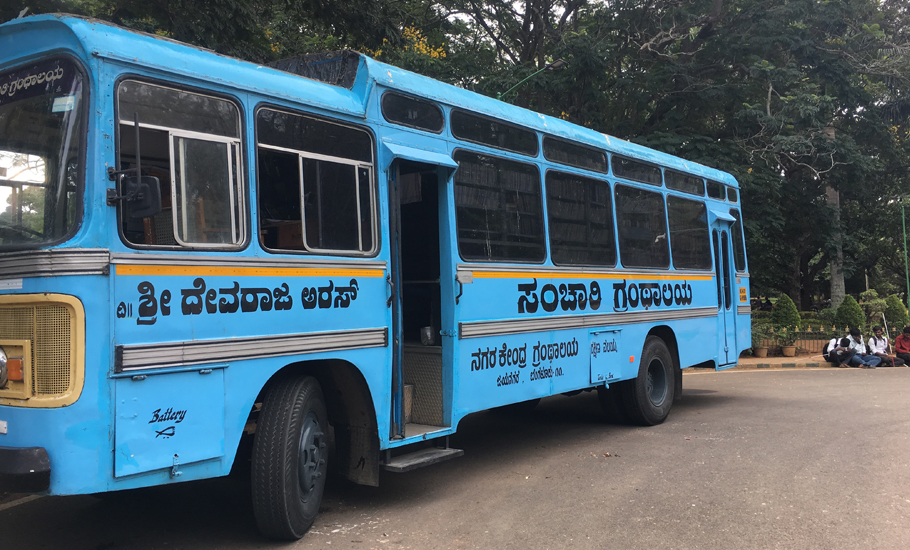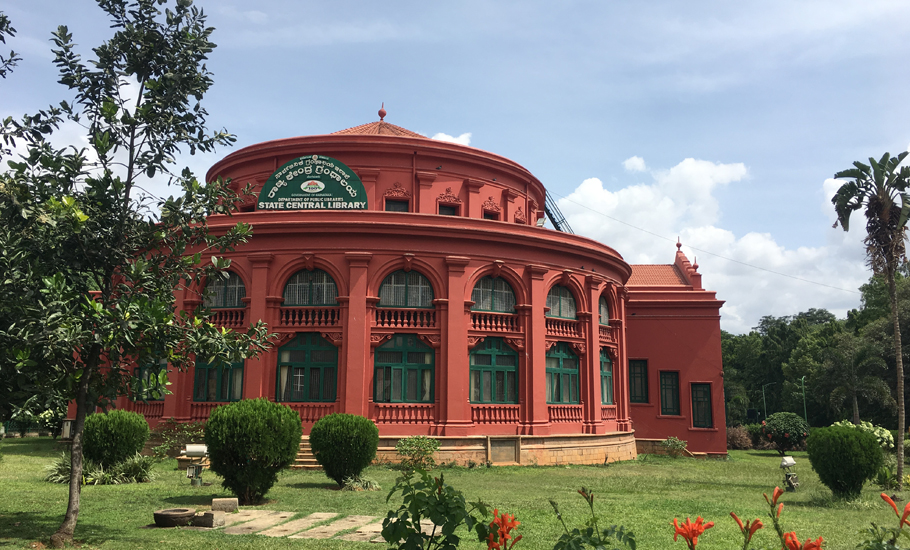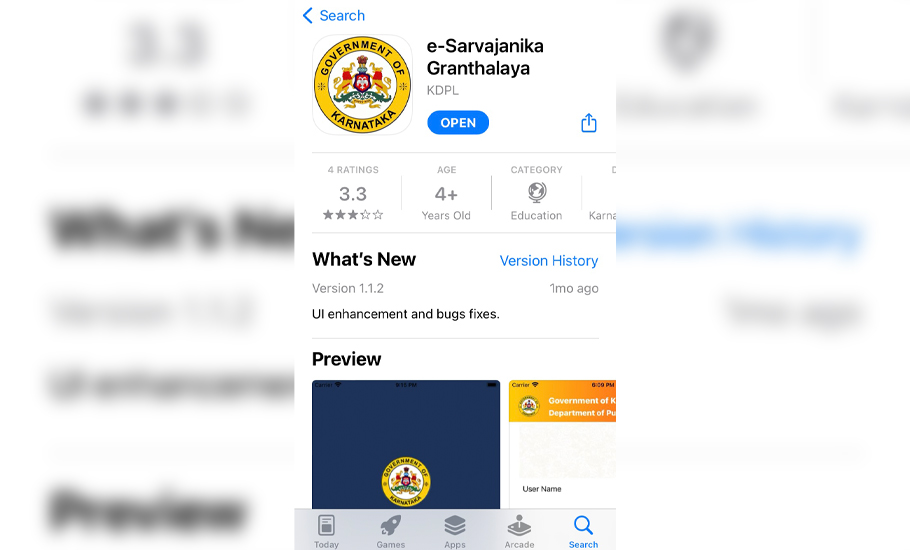
- Home
- News
- Analysis
- States
- Perspective
- Videos
- Education
- Entertainment
- Elections
- World Cup 2023
- Features
- Health
- Business
- Series
- Economy Series
- Earth Day
- Kashmir’s Frozen Turbulence
- India@75
- The legend of Ramjanmabhoomi
- Liberalisation@30
- How to tame a dragon
- Celebrating biodiversity
- Farm Matters
- 50 days of solitude
- Bringing Migrants Home
- Budget 2020
- Jharkhand Votes
- The Federal Investigates
- The Federal Impact
- Vanishing Sand
- Gandhi @ 150
- Andhra Today
- Field report
- Operation Gulmarg
- Pandemic @1 Mn in India
- The Federal Year-End
- The Zero Year
- Premium
- Science
- Brand studio
- Home
- NewsNews
- Analysis
- StatesStates
- PerspectivePerspective
- VideosVideos
- Entertainment
- ElectionsElections
- Sports
- Loading...
Sports - Features
- BusinessBusiness
- Premium
- Loading...
Premium

Take it as you like it: Digital to on-wheels, Karnataka libraries spoil readers for choices

Back in the 1980s, the big blue bus parked alongside a lane with a queue of residents waiting patiently outside its door was a familiar sight in Bengaluru’s residential localities. Inside the vehicle, the walls were stacked with books that beckoned irresistibly—the mobile library rolled up on designated days by which time its patrons, young and old, would have lined up to greet...
Back in the 1980s, the big blue bus parked alongside a lane with a queue of residents waiting patiently outside its door was a familiar sight in Bengaluru’s residential localities. Inside the vehicle, the walls were stacked with books that beckoned irresistibly—the mobile library rolled up on designated days by which time its patrons, young and old, would have lined up to greet it.
These buses, run by the public libraries’ department, still ply the city’s roads between 11 am and 5 pm every day, reaching readers in several localities— that, in itself, is testament to their utility. The overall backdrop, of course, has changed in all these years and dramatically so, like a time-lapse effect.
You can now land straight at the library, fill in a username and password, get in and start browsing the collection—all on your mobile phone.
Two years ago, just before the pandemic struck, Karnataka’s government-run public libraries had made the digital transition. Since then, about 372 public libraries across the state—in cities, at district headquarters and talukas—have gone online.
So far, about 2.19 crore members have registered on the Karnataka Digital Public Library (KDPL) portal—cumulatively, about 21 lakh e-resources have been viewed so far.
These statistics make Karnataka a frontrunner in digital public libraries, points out Satishkumar S Hosamani, director, Department of Public Libraries. “In 2020 when our libraries were closed for nearly five months because of the pandemic, we spoke of this initiative through television, newspapers and radio. That reached the grassroots and we got a good response because people were all confined to their homes,” he says. “The enrolment numbers are high because we went to schools, colleges, universities and all the government departments.”

Currently, the title count available on the KDPL portal stands at a little over one lakh. This includes e-books, e-journals and video material—a mix of both scanned books where copyright permissions have been obtained and original digital material. Students top the target audience. “From the first standard to 12th, we have textbooks and also books for competitive exams,” says Hosamani.
Districts such as Bangalore and Dakshina Kannada currently top the registration count with about 60 lakh and 21 lakh members respectively followed by northern districts such as Haveri, Kalaburgi and Gadag which have 15-18 lakh members each. The number of active users at any given point would vary, points out Hosamani.
The public library space is indeed dynamic in Karnataka, agrees veteran librarian Dr PV Konnur, who formerly headed the state’s books selection committee.
The beginning of the movement to digitise libraries in India goes back 20 years to the Carnegie Mellon University’s ‘Million Book to the Web Project’ and the initial effort to scan existing collections at Indian libraries which subsequently led to the Digital Library of India (DLI).
“That was the first time a digitisation project was introduced,” recounts Konnur who was then university librarian at Goa University. “All across the country, scanners were given by Carnegie Mellon. In fact, in Goa, we digitised a lot of the old rare collections that were there in our library.” Books dating back to 1924 or earlier are copyright-free—even there libraries have to carefully choose which ones to digitise so as to save time and resources, he says.
Konnur sets out the defining feature, and thereby the challenges, of any digital public library—the collection of e-resources, he explains, naturally have to be material that are ‘born digital’, that is, originally created on a computer.

“There are two components. One is a born-digital book and the other one is a scanned book. The scanned book is only possible if it is a rare book or if the copyright holder has given the copyright of scanning it…there are very low chances of getting it.”
Hence, a lot of digital content currently tends to be open-access material, he points out. But merely having a collection of open-access digital books isn’t enough, he says.
Libraries at universities have had the headstart when it comes to digital content. As Konnur points out, their access to digital soft copies is usually better, given that publishers know there are a definite number of students who will be using it. “If you give the same content to a public library, the publisher doesn’t know how many users are there. So, these publishers will not put their content on public library websites at all.”
Hence, Konnur reckons public libraries which order large numbers of copies from publishers should devise methods to obtain access to a soft copy of the content. “That will make it born-digital. You can convert it into a flipbook so that can be used by the public at large. So public libraries should give more attention to this kind of a collection development rather than developing only open-access books.”
For this approach to materialise, he suggests that the Karnataka government puts in place a policy so that public libraries can evolve a system to negotiate with publishers. With digital rights management (DRM) software, several possibilities can be explored. For instance, limiting access to a certain number of users at any given time for an e-book, he suggests. When all the e-book copies of a given title are in use, new users would have to wait in a queue until the copies are freed-up, he suggests. “DRM systems means no book can be downloaded, they can only be read on the machine. Readers can borrow the books for 15 days and after that it should vanish from their machines. So many technological things can be done, but government should make a policy.”
The library, as we know it, is currently an amalgam of several models, each one of them co-existing. Like how Karnataka’s library-on-wheels coexists with the digital model—currently there are 12 buses across the state and Hosamani says these vehicles too offer tablets and computers for readers to access the digital portal.

Several models coexist in the world of private lending libraries too, points out Kochi-based Anup Luiz who runs Eloor Lending Libraries in four cities in south India. “Some people are digitising old stuff, some people are allowing for door lending to happen, some people are giving digital books and some people are doing it our way,” says Luiz, whose libraries have largely followed the same lending model over the last 40 years. He reckons that in the future, perhaps when finances are available, he would consider a warehouse-model of setting up satellite libraries to get closer to the readers.
“The impact of corona is certainly evident where a lot of people are afraid of coming to a library and taking books. That is certainly there. But at the same time if you see different cities on different days have a different trend,” he says. For Eloor, the branches at Thiruvananthapuram and Bengaluru have always been the highest grossing libraries, he says.
Konnur reckons digital public libraries have a long way to go. “In fact, every day you add new ideas because of technological advancements. When Google had come, many people had thought that libraries would go away. But libraries have not vanished. And libraries are gaining importance day after day,” he says. “Though walk-in users have reduced these days, the library usage has been increased drastically. We are able to deliver them information on their doorsteps,” he says.

